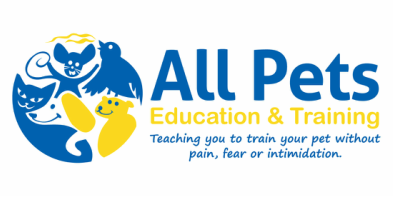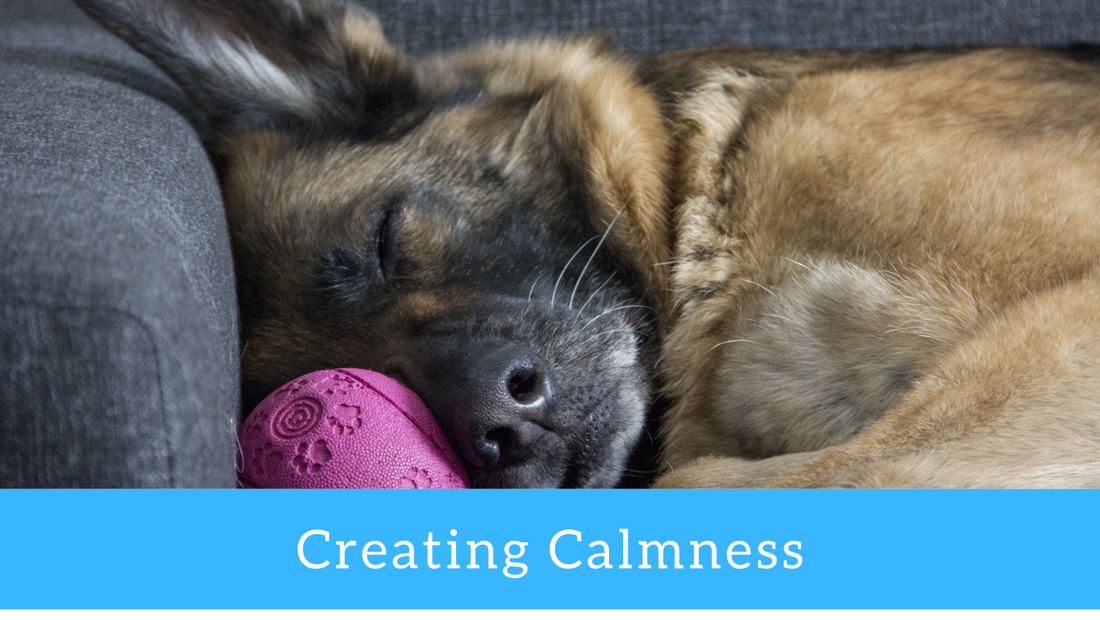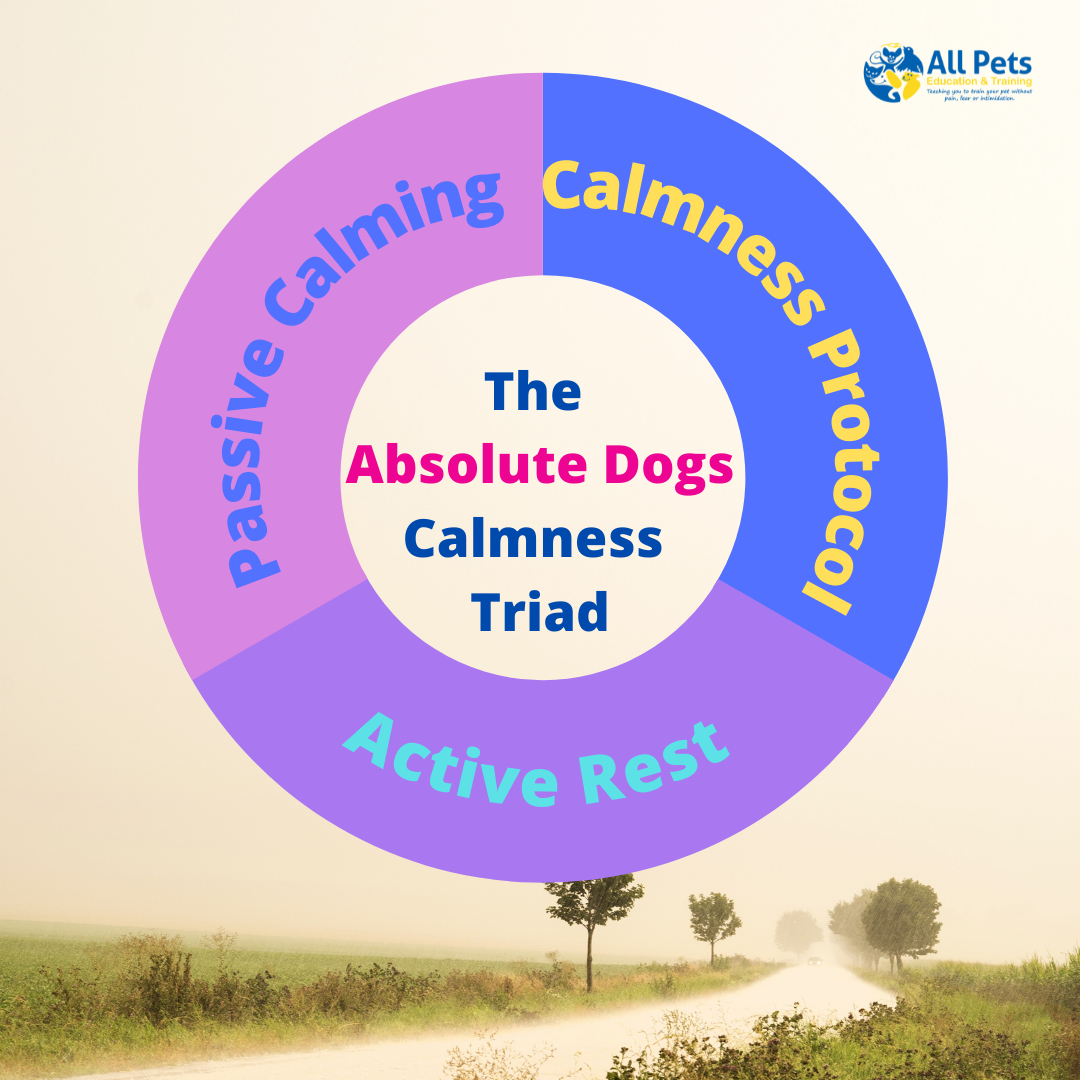Creating Calmness
Some dogs need to learn how to be calm
Feb 2022
Sometimes we have dogs that are over aroused, anxious or over stimulated. They act in ways that we would rather they didn’t, but they don’t have the skills to calm themselves down.
Signs of over-aroused behaviours might including biting, barking, lunging, mouthing, ignoring you, destroying things, anxiety, whining, humping (dogs), jumping, stealing items and running, unable to eat etc.
Getting frustrated or angry with them, will just increase the problem, as the dog ends up further stressed, anxious or overstimulated. Refer to the adrenaline handout and the bucket scenario.
So what do we do?
Take this information and help teach our dogs how to calm. The more an animal practices something the better they get at it. Remember practice makes perfect. So, make calmness part of your pet’s daily life.
An animal will become what they rehearse.
So consider this in a variety of scenarios
Absolute dogs describe the Calmness Triad – and this is a great framework to follow. (Mitchell and Langman)
Using the Calmness triad of
Signs of over-aroused behaviours might including biting, barking, lunging, mouthing, ignoring you, destroying things, anxiety, whining, humping (dogs), jumping, stealing items and running, unable to eat etc.
Getting frustrated or angry with them, will just increase the problem, as the dog ends up further stressed, anxious or overstimulated. Refer to the adrenaline handout and the bucket scenario.
So what do we do?
Take this information and help teach our dogs how to calm. The more an animal practices something the better they get at it. Remember practice makes perfect. So, make calmness part of your pet’s daily life.
An animal will become what they rehearse.
So consider this in a variety of scenarios
- Rehearsing lots of over excited behaviours, creates an over excited animal
- Rehearse the room/space – if there are areas you would like your pet to practice calm behaviours, only do calm behaviours in this area. Ie if the lounge room is time for rest, don’t play ball in the lounge…instead practice some station, crate or bed behaviours.
- Animals that practice lots of calm, will have a default calm state. Yes they will be able to have increased arousal levels for training/play etc, but when you aren’t actively engaging, they should default to calm.
Absolute dogs describe the Calmness Triad – and this is a great framework to follow. (Mitchell and Langman)
Using the Calmness triad of
- Passive Calming Activities,
- Calmness Protocol
- Active Rest
So what does this mean?
Rotate through the activities and plan your day and your dog's day using these.
If Calmness is a big struggle, commit for the next 3 weeks to focusing on growing calmness and using the greater proportion of your dogs food for this. So aim for 60% of the daily food allowance delivered through calmness activities.
Don’t expect an overnight miracle, its not how it works, but do expect to see small changes each and every day. Document and measure it so that you can see the growth. And its unrealistic to not expect ups and down, however the small wins should outnumber the setbacks.
Let’s looks at the individual strategies
Passive Calming activities
These include using enrichment to feed out pets. It could be as simple as a kibble scatter, a frozen lick mat, stuffed kong, chewy bone, dehydrated tendons etc. Just make sure whatever you are using, your dog enjoys and we do not increase arousal through frustration.
When introducing enrichment, start simple and build the difficulty as your dogs skills grow as well.
If you have a species other than a dog – talk to me and we can think of species appropriate enrichment for them too
Calmness Protocol
Using the calmness protocol, we want to actively pay attention, and feed your animal calmly when they are in a relaxed state.
You can also use external distractions as a cue to feed the animal – so instead of an outward reaction from the animal they pair the external distraction with something desirable and promote calm and disengagement from those external triggers.
Using safe spaces to confine your animal when you are not able to supervise and prevent them from rehearsing undesirable behaviour. These spaces need to be comfortable, meet the animals needs and also provide some form of long term enrichment at the same time.
Active Rest
This is when you make a note to ensure your animal has adequate down time and is able to rest.
Did you know dogs 12-14 hours of quality rest or sleep per day, and older or recovering dogs may need more.
Puppies will need 18-20 hours of quality rest or sleep per day.
Without quality rest, our dogs cannot recover, rest and repair. They are more likely to have gastrointestinal issues, weakened immune systems, feel anxious and show reactive, irritable or grumpy behaviours.
For active rest you can use
And what games can you play that promote calmness but also work your dogs brain?
Remember if over arousal etc is a big struggle, commit for the next 3 weeks to focusing on growing calmness, and spending 60% of your dogs food allowance (or more) on growing calmness instead.
Works Cited
Advisor, Sleep. “How Many Hours a Day Do Dogs Sleep? How Much Do They Need?” Sleep Advisor, 13 June 2021, www.sleepadvisor.org/how-much-do-dogs-sleep/ . Accessed 11 Feb. 2022.
Allan, Trish. “Sleep - Why It Is so Important.” All Pets Education and Training, 2019, www.allpetseducationandtraining.com.au/sleep---why-it-is-so-important.html.
Mitchell, Tom, and Lauren Langman. Boundary Games. Absolute Dogs.
Morrell, Virginia. “Brain Scans Show Dogs Learn When Sleeping—Just like People.” Www.science.org, 13 Oct. 2017, www.science.org/content/article/brain-scans-show-dogs-learn-when-sleeping-just-people.
Rotate through the activities and plan your day and your dog's day using these.
If Calmness is a big struggle, commit for the next 3 weeks to focusing on growing calmness and using the greater proportion of your dogs food for this. So aim for 60% of the daily food allowance delivered through calmness activities.
Don’t expect an overnight miracle, its not how it works, but do expect to see small changes each and every day. Document and measure it so that you can see the growth. And its unrealistic to not expect ups and down, however the small wins should outnumber the setbacks.
Let’s looks at the individual strategies
Passive Calming activities
These include using enrichment to feed out pets. It could be as simple as a kibble scatter, a frozen lick mat, stuffed kong, chewy bone, dehydrated tendons etc. Just make sure whatever you are using, your dog enjoys and we do not increase arousal through frustration.
When introducing enrichment, start simple and build the difficulty as your dogs skills grow as well.
If you have a species other than a dog – talk to me and we can think of species appropriate enrichment for them too
Calmness Protocol
Using the calmness protocol, we want to actively pay attention, and feed your animal calmly when they are in a relaxed state.
You can also use external distractions as a cue to feed the animal – so instead of an outward reaction from the animal they pair the external distraction with something desirable and promote calm and disengagement from those external triggers.
Using safe spaces to confine your animal when you are not able to supervise and prevent them from rehearsing undesirable behaviour. These spaces need to be comfortable, meet the animals needs and also provide some form of long term enrichment at the same time.
Active Rest
This is when you make a note to ensure your animal has adequate down time and is able to rest.
Did you know dogs 12-14 hours of quality rest or sleep per day, and older or recovering dogs may need more.
Puppies will need 18-20 hours of quality rest or sleep per day.
Without quality rest, our dogs cannot recover, rest and repair. They are more likely to have gastrointestinal issues, weakened immune systems, feel anxious and show reactive, irritable or grumpy behaviours.
For active rest you can use
- Crates/pens
- Rooms (close windows/curtains/or put up window film)
- Calming/snuggle beds (usually within the crate/pen or room to begin with)
- More experienced dogs can use dog beds without confinement
And what games can you play that promote calmness but also work your dogs brain?
- Boundary or mat training – mix and match and make it fun. Do stuff off the bed and boundary too….but more food comes when the dog chooses to be on it. Make it the place of reinforcement and value https://absolutedog.s3.amazonaws.com/ebooks/BoundaryGames_V5.pd (Mitchell and Langman)
- Practice sending to boundary/mat from further and further away as well, and slowly increasing distractions while the dog chooses to stay on.
- Disengagement games
- Calm and slow feeding
Remember if over arousal etc is a big struggle, commit for the next 3 weeks to focusing on growing calmness, and spending 60% of your dogs food allowance (or more) on growing calmness instead.
Works Cited
Advisor, Sleep. “How Many Hours a Day Do Dogs Sleep? How Much Do They Need?” Sleep Advisor, 13 June 2021, www.sleepadvisor.org/how-much-do-dogs-sleep/ . Accessed 11 Feb. 2022.
Allan, Trish. “Sleep - Why It Is so Important.” All Pets Education and Training, 2019, www.allpetseducationandtraining.com.au/sleep---why-it-is-so-important.html.
Mitchell, Tom, and Lauren Langman. Boundary Games. Absolute Dogs.
Morrell, Virginia. “Brain Scans Show Dogs Learn When Sleeping—Just like People.” Www.science.org, 13 Oct. 2017, www.science.org/content/article/brain-scans-show-dogs-learn-when-sleeping-just-people.


